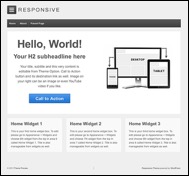"Rhetorical Web Design: Thinking Critically about Ready-Made Web Templates and the Problem of Ease"
|
Jason ThamJason Tham is a PhD student in the Rhetoric and Scientific and Technical Communication program at the University of Minnesota in Twin Cities. His current research includes connected knowledge making and sharing, digital and visual rhetorics, and new inventions in writing and communication technology. His scholarly works have appeared in Journalism & Mass Communication Quarterly, Intercom, and Digital America: Journal of Digital Culture and American Life. ContentsOf Ease & Efficiency: The Problem with Template-Driven Web Designs Agency, Techne, and Extreme Usability Agency, Techne, and Extreme Usability Analysis of a Template: WordPress.com |
Analysis of a Template: WordPress.comTo explicate the concerns central to the use and misuse of “easy,” ready-made solutions, this section will briefly examine a template design from one of the most popular CMSs at present, WordPress.com, and its design flexibility. Launched in May 2003, WordPress is a free and open-source blogging tool and a CMS based on PHP and MySQL, which run on a web hosting service. Features include a plug-in architecture and a template system. WordPress is the most popular[1] blogging system in use on the web, with more than 60 million websites (Coalo, 2012). WordPress offers two kinds of CMS platforms: WordPress.com and WordPress.org. On the one hand, WordPress.com gives users a free blog they can use to post content but they are not allowed to use it for commercial purposes. Users can upgrade to the premium account if they would like to get an ad-free site with a personalized domain name, popular themes, custom design, and other options. On the other hand, WordPress.org offers a free downloadable file that helps users to manually create a database onto their web host and install their blog. Today, most web-hosting firms offer a free WordPress installation option with their service. That means with a self-hosted WordPress platform, users can install a blog without having to manually create a database or deal with coding. For this analysis, I review template designs from WordPress.com since it is the CMS I am most familiar with. I focus this analysis on Responsive Theme (see Figures 1 and 2), a web design developed by CyberChimp, a third-party web development company for WordPress. The theme is available both for free (with limited color schemes and typography) and with a cost of $34.99[2] (with extended color schemes, typography, and additional plugins).  Figure 1 - Front Page of Theme
 Figure 2 - A Parent Page of ThemeTo demonstrate what a user can and cannot do with the template theme, I use a personal example that was “designed” using the Responsive Theme (Figures 3 and 4). With an eye toward my rhetorical intentions and the capacity of the template in helping me achieve those goals, I examine closely my personal website as a designed interface to uncover the restrictions of locked design in ready-made web templates. To start, I face great limitation in customizing my personal front page and subpages for an accurate representation of my identity as a teacher and student. Similar to Arola’s (2010) experience, I was constrained by the template framework and built-in features. On the landing page, I could not interchange the location of the main menu, nor could I get rid of the welcome panel and replace it with, say, a YouTube video or a running slideshow. While I could certainly control most of the content to publish on the main and subpages, the layout of the text panels remained the same. And since I opted for the free version, most of the graphical elements remained in place: the menu bar is always dark grey, the links are always blue, and the text is always a sans-serif font.  Figure 3 - Front Page of My Personal Website Figure 4 - A Parent Page of My Personal Website
____________________________________________________________________ [1] WordPress is used by more than 18.9% of the top 10 million websites as of August 2013 (w3techs.com, 2014). [2] As of April 6, 2014. |